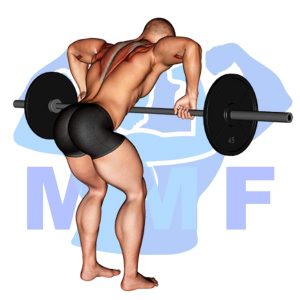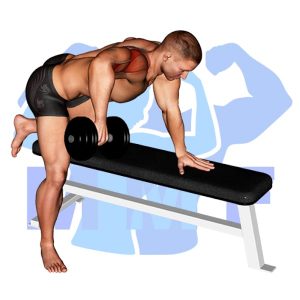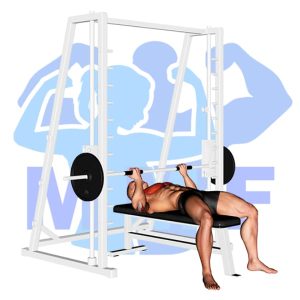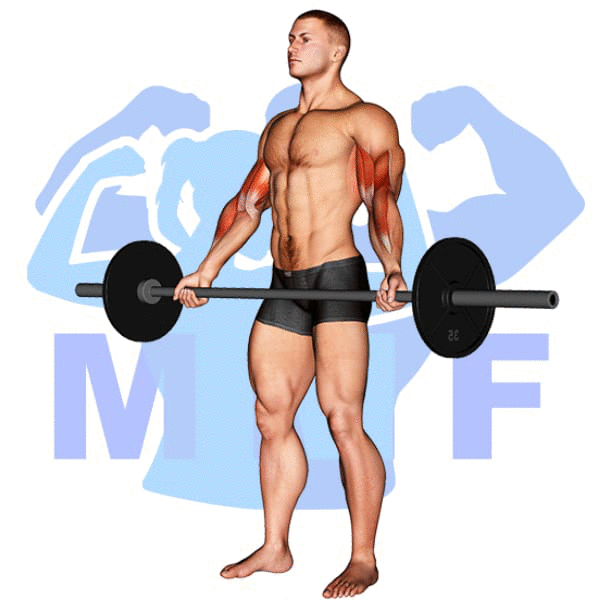Do you feel like your back muscles aren’t getting the attention they deserve during your workouts? Perhaps you’re doing countless repititions of traditional dumbbell or cable rows, but haven’t seen much improvement in your back strength. It’s a common issue that many of us face in the gym. The cause can often be attributed to a lack of variation and resistance. Luckily, there’s a little-known exercise called the “barbell pendlay row” that could be the solution you’re looking for. In this post, we’ll break down the benefits of this exercise and provide step-by-step instructions on how to perfect your form for optimal results.
Barbell Pendlay Row Summary
- Primary Muscles: Deltoid – Posterior
- Secondary Muscles: Brachialis, Brachioradialis, Infraspinatus, Latissimus Dorsi, Rhomboids, Teres Minor, Trapezius – Lower, and Trapezius – Middle
- Equipment: Barbell
- Mechanics Type: Compound
- Force: Pull
- Utility: Basic

Barbell Pendlay Row Instructions
- The fundamental difference between the Pendlay row and a typical bent over row is support vs. non-supported start.
- For the Pendlay row, you set the bar on the ground at the end of each rep. You can also use other supports as well such as blocks or a rack.
- To begin, step up to the bar on the ground. Bend your knees and bend over with your hips with you back straight and arms fully extended.
- Grasp the bar with an overhand grasp somewhat wider than shoulder-width.
- Pull the bar to your sternum.
- Flex once at the top, then lower the bar straight back down until the bar is back on its support or the ground.
- Repeat for your desired number of reps.
- One benefit of the Pendlay Row is that by increasing the rest between each rep you can do many more reps until complete failure.
Video Tutorial
Barbell Pendlay Row Muscles
Target (Agonist)
Synergists
- Brachialis
- Brachioradialis
- Infraspinatus
- Latissimus Dorsi
- Rhomboids
- Teres Minor
- Trapezius – Lower
- Trapezius – Middle
Dynamic Stabilizers
Stabilizers
Antagonist Stabilizers

Benefits of Barbell Pendlay Row
The Barbell Pendlay Row is an effective exercise to target the posterior deltoids, which are important for shoulder stability and strength. This exercise helps to build strength in the posterior deltoid muscles, which can help improve shoulder mobility and reduce the risk of injury. Additionally, it is an efficient way to increase upper body strength and size, as well as improve posture by strengthening the upper back muscles. With proper form and proper weight, the Barbell Pendlay Row can help to tone and strengthen the posterior deltoid muscles, resulting in improved shoulder stability and strength.
Tips for Performing Barbell Pendlay Row
. The Pendlay Row is an effective exercise for developing strength in the back and core muscles. To maximize your results, it’s important to use proper form. Below are some tips to help you get the most out of this exercise.
- Balance Your Bar To Make Sure You Work Symmetrically.
- Execute Power Sets. Is where you do a set of a pair of distinctive lifts back to back. Now there are 2 primary options to accomplish power sets, primary is to concentrate on one muscle. The other is to target the opposite muscle groups.
- execute your large compound movements at the beginning of your routine, next conduct isolation movements to target distinct muscle groups afterward. You really want the pinnacle functionality of your individual muscle groups when you do compound lifts like deadlifts, bench, and squats. After that, you want to work the muscle zones of which you determined were weak for those lifts, or zones that couldn’t get worked based on the style of compound lift you conducted.
- To Improve Power And Speed, Bring Up The Velocity Of Your Movements. Continue to keep effective form or you might be more suboptimal to injury. You ought to reduce the weight to 50-60% of your 1RM when weightlifting for power. However, you ought to stop between every repetition.
Benefits and Tips Video
Frequent Mistakes To Avoid
The Barbell Pendlay Row is an effective exercise to help you reach your fitness goals, but it’s important to know how to do it correctly. There are a few common mistakes to avoid in order to maximize your results. To ensure that you are doing the exercise correctly and getting the most out of it, here is a list of the most common mistakes to avoid when doing a Barbell Pendlay Row.
- You’ll Do Better To Not Execute The Exact Same Exercises Each And Every Occasion. When people execute the exact exercise every work out ones muscle groups is likely to be conditioned to accomplike that individual exercise well, but you will peak a lot quicker.
- You Must Not Make It To Easy. Your main way to obtain gains will be to challenge yourself.
- Avoid The Urge To Skip Rest Days. Over-training can easily actually make you weakened instead of bigger.
Find More Barbell Exercises Here
Variations and Complementary Exercises
The Barbell Pendlay Row is a great exercise to target your lats and mid-back muscles, but if you want to switch it up and target the same muscles in a different way, there are several variations, complementary, and alternative exercises you can do. Below are some of the best exercises that work similar muscles as the Barbell Pendlay Row.
Barbell Rear Delt Row

The Barbell Rear Delt Row is a great complementary exercise to the Barbell Pendlay Row. It focuses on targeting the rear delts, which is an area that the Pendlay Row does not target. This exercise is done by holding a barbell with a grip slightly wider than shoulder width, and pulling it up towards your chest while keeping your elbows close to your body. The Barbell Rear Delt Row is an effective exercise for developing the muscles of the back, and is an excellent alternative to the Pendlay Row if you are looking to target specific muscle groups.
Cable Rope Face Pull

The cable rope face pull is an excellent alternative or complementary exercise to the barbell Pendlay row. It is a great way to target the same muscles as the Pendlay row, such as the back, traps, and rear delts, but in a slightly different way. The cable rope face pull requires more stability and core engagement than the Pendlay row, as it requires you to keep your body in a neutral position throughout the exercise. Additionally, the cable rope face pull allows for more range of motion than the Pendlay row, which can help to increase muscular activation and provide a greater degree of stimulation.
Dumbbell Chest Supported Row

The Dumbbell Chest Supported Row is an excellent complementary or alternative exercise to the Barbell Pendlay Row. It works the same primary muscles, with the added benefit of less stress on the lower back due to the supported torso position. This exercise also helps to engage the stabilizing muscles of the shoulder and upper back, which can be neglected when performing the Barbell Pendlay Row. Furthermore, this exercise can be performed at a higher volume with less risk of injury due to the reduced loading.
Check Out These Top Barbell Exercises
Dumbbell One Arm Row

The Dumbbell One Arm Row is a great complementary or alternative exercise to the Barbell Pendlay Row. This exercise strengthens the lats, rhomboids, and middle back muscles and is a great way to target each side of the body separately. The Dumbbell One Arm Row is performed by standing with one knee and one hand on a flat bench, with the other foot and hand on the ground. The arm holding the dumbbell should be extended directly down and then pulled up towards the chest, engaging all of the back muscles. This exercise can be done with a lighter weight than the Barbell Pendlay Row for those just starting out, or it can be done with a heavier weight to increase intensity.
Seated V Bar Cable Row

Seated V Bar Cable Row is an excellent alternative or complementary exercise for the Barbell Pendlay Row. It helps to target the same muscle groups and works the same motion. The difference is that it is done seated, which helps to reduce any strain on the lower back. Additionally, the handle of the V Bar cable row helps to place more emphasis on the lats and rhomboids, as opposed to the Barbell Pendlay Row which works the lower back more. This makes it an ideal choice for those looking to build their lats and rhomboids.
T Bar Supported Reverse Grip Row

The T Bar Supported Reverse Grip Row is an effective alternative or complementary exercise for the Barbell Pendlay Row. It is a great way to vary your back training routine and can be used to target the lats and other upper back muscles in different ways. The T Bar Supported Reverse Grip Row works by having the lifter stand between two T bars, gripping them with an underhand grip, and pulling the weight towards the chest. This motion helps to build strength and stability in the back muscles, while also helping to improve overall posture. With the T Bar Supported Reverse Grip Row, lifters can focus on their form and technique while also building strength in the upper back muscles.
Find More Back Exercises Here
Opposing Complementary Exercises
To round out your workout, it’s important to include exercises that use the opposite muscles as the Barbell Pendlay Row. Doing so will help to ensure that your muscles are receiving a balanced workout. Below is a list of exercises that will help to complement the Barbell Pendlay Row:
Assisted Wide Grip Chest Dip

The Assisted Wide Grip Chest Dip is a great exercise to complement the Barbell Pendlay Row as it works the opposing muscle group. This exercise works the chest muscles, specifically targeting the pectoralis major, while the Barbell Pendlay Row works the back muscles. Doing both exercises together allows you to build strength and balance in both the chest and back muscles. The Assisted Wide Grip Chest Dip also helps to improve mobility and stability in the shoulder joint, which is an important factor in being able to perform the Barbell Pendlay Row with correct form.
Smith Machine Reverse Grip Press

The Smith Machine Reverse Grip Press is a great complementary exercise to the Barbell Pendlay Row. It works the opposite muscle group, targeting the chest and shoulders. The reverse grip helps to engage the chest more and helps to keep the back in a neutral position. As with the Pendlay Row, this exercise can be done in a slow, controlled manner to really target the muscles and ensure proper form is being maintained. Doing both exercises together helps to create a balanced workout that can help to build strength and tone the muscles of the chest, shoulders, and back.
Lever Chest Press (Machine)

The Lever Chest Press (Machine) is an excellent exercise for those looking to build their chest and upper body strength. It targets the chest muscles, specifically the pectoralis major and minor, as well as the anterior deltoids. This exercise is great for building size and strength as it allows for heavy weight to be used. It is also complementary to the Barbell Pendlay Row, as it works the opposing muscle group. The Barbell Pendlay Row primarily works the back muscles, such as the latissimus dorsi and rhomboids, while the Lever Chest Press (Machine) works the chest muscles. By working both of these muscle groups in opposing fashion, the exerciser will be able to gain maximum benefits from their workout routine.
Transform Your Back With The Barbell Pendlay Row
Looking to transform your back? The Barbell Pendlay Row might just be the exercise you need to add to your routine. This compound movement targets the entire back, including the lats, traps, and rhomboids. By focusing on form and technique, you can increase strength, improve posture, and even reduce the risk of injury. Plus, the added benefits of increased grip strength and core stabilization make this exercise a must-try for anyone looking to enhance their overall fitness.
References: Wikipedia | ExRx.net | PubMed.gov | Comprehensive List of Back Barbell Exercises




